I no longer post to my blog, but it contains several years worth of short articles I've written regarding various painting tips, thoughts, and inspiration for pastelists and oil painters. I began the blog in 2011 simply as a resource for students I taught at my studio at the time. I stopped posting in 2018, but even though I've grown in my artistic journey since then, much of what I've shared here is still relevant, and therefore I've kept it visible for anyone who cares to skim though it.
Friday, December 21, 2012
Merry Christmas to All!
Just a quick little note to wish you all holiday greetings and to say thanks for following my blog. The comments and feedback that you all contribute are very appreciated and I thoroughly enjoy reading them all.
I'm looking forward to a busy, but hopefully exciting 2013, with some workshops to teach, conventions to attend and a solo show that I'll be talking more about soon!
Wishing you all a fantastic 2013!
Friday, December 14, 2012
Getting Things Going
 |
| Work in progress (not yet titled), oil, 14x18 |
Because of holiday commitments closing in, I may have to put this piece on hold for a bit. Who knows, maybe I'll be able to squeeze in some more time on it next week. I usually don't like to have such a long hiatus between the start of a painting and when I can continue on it. Often I lose sight of what initially inspired me to paint it. Hopefully, though, I've captured enough here to keep me going once I have time to continue.
I've come to think that one of the most important aspects of the the beginning stages of a painting is to keep things changeable and not overdefine too much. There are sometimes key elements that I do want to lock into a specific spot, but otherwise, I want to keep my edges sort of "mushy" so I can tweak them this way or that as the painting evolves. This also helps me to keep my edges soft in less important areas of the painting.
Below are a couple of other examples of paintings in early stages.
 |
| Initial underpainting for "December Heat Wave" pastel, 16x20 |
 |
| Roughly the middle stage of "Rum River" pastel, 16x20 |
This example above is a little further along, but I still held off as long as possible to define many details. And even when I decided the painting was finished, I left some areas undefined that I originally thought I would work on some more.
Now...to the gift wrapping and cookie baking!
Friday, December 7, 2012
"River Magic" Progression
 |
| River Magic, pastel, 12x16 |
Back in the studio I looked over some photos I took of the scene. I also tried something with the photos that I hadn't done in awhile. I went into Photoshop and increased the color saturation...not a lot, but just enough to have some additional color information to work with in the painting. Since it was somewhat of a backlit scene, the light was pretty flat in most areas except for the thin highlights on the trees and in a few spotty places on the water. I needed to find a way to create interest in the water and background trees without the use of very much value contrast. When I don't have value contrast to work with, I often make use of color contrast to create interest.
 |
| original photo |
 |
| Increasing the saturation in Photoshop basically exaggerates what little bit of color is already present. |
 |
| my plein air version (oil) |
The dramatic highlights on the trees were what originally caught my eye when painting this on location, so I still wanted to be sure to capture that in my next attempt. I think I did manage to get some of that down in the plein air version.
Since I decided that color was going to play a key role in my pastel version, I started with a more colorful underpainting rather than my usual monochromatic value structure.
A few demo shots of the beginning stages...
 |
| initial layers using Nupastels |
 |
| alcohol wash |
 |
| getting the background going |
I have many failed plein air paintings, but I consider each and every one very valuable time spent. Each one represents more time studying the landscape and learning its nuances. For this particular one, I wanted to try the studio version very soon after the plein air attempt so that much of the scene would still be fresh in my memory. It really was a very beautiful, magical spot along the Chattahoochee River on the day I painted there, and that's what I wanted to capture with the dramatic backlighting and subtle color contrasts. It's a nearby location for me, so hopefully I'll be back to paint there many more times!
Thursday, November 29, 2012
Make Your Holidays Sparkle (With Value Contrast!)
 |
| Holiday Prep I, pastel, 9x12 |
 |
| Holiday Prep II, pastel, 9x12 |
I chose the items for these still life set ups with a wide variety of surface textures in mind. In each, I purposely chose a mat finish ornament to go beside the other shiny ornaments. The transparent satin ribbon, cloth background and smooth wood surface also added a nice variety of textures to study closely.
Some of the ornaments also had textured decorations on them. It was interesting to note that even though some of the sparkly designs on the ornaments were actually white in color, the highlights on the shiny ornaments were still lighter in value than the white areas, just due to the fact that the nondecorated area of the ornament was very reflective. The white areas were not a shiny texture and therefore didn't reflect nearly as much light. Shiny, reflective objects tend to have larger extremes of lights and darks than less shiny objects with more of a mat finish. The black fabric in the background is the least reflective and has the least amount of value contrast.
For both of these pieces, I started with a quick monochromatic underpainting using an alcohol wash on mounted Uart 320 paper.
 |
| Underpainting for Holiday Prep I |
 |
| The set up for Holiday Prep I |
Monday, November 19, 2012
AAC Demonstration
 |
| Morning Radiance, pastel, 14x11 |
Morning Radiance was painted on mounted Uart paper with a monochromatic alcohol wash underpainting. In the underpainting stage, I focused on not only setting up the value structure for the painting, but simplifying the busy tree foliage into large, connected shapes. By contrasting the foreground and background with value and color temperature, I attempted to create a dramatic glow of light that was radiating from behind the thick foliage.
Thursday, November 8, 2012
Using Your "Ugly" Pastels
 |
| A Welcome Change, pastel, 12x9 |
 |
| Mountaintop Trees, pastel, 9x12 |
This week in my classes, we continued with autumn landscapes and focusing on balancing the brights with the greyed/muted colors.
I've noticed that most new pastel artists who are just getting started collecting their supply of pastels are usually lacking those all important dull, ugly pastels. They're the colors we usually overlook because we think those colors will make the whole painting appear dull. In reality, they'll help get more mileage out of those gorgeous, saturated colors we love to use.
When deciding what colors to use for a painting that has bright colors, start by scribbling little color patches next to each other, finding one or two dull sidekicks for each bright color you need. These dull colors are greyed versions of each color family or very muted neutrals...they're usually those nondescript colors that are difficult to give a color name. The dull color you actually need is usually duller (and uglier) than you think.
Thursday, November 1, 2012
Grey Matters
 |
| Fading Autumn Light, pastel, 9x12 |
In my demo (above) I began with very muted hues and greyed versions of the bright autumn colors that would ultimately be added in later stages. Adding those bright hues is definitely a "less is more" practice...a little dab of a bright color up against a grey or muted hue goes a long way!
I wasn't completely pleased with composition on this one...things ended up a bit too centered for my taste. "Fading Autumn Light" may be considered for the chopping block, and possibly come back to life as a smaller size. Still thinking about it.
We'll probably do one more class that focuses on greys in the autumn landscape.
***
In my Monday class earlier this week, we focused on edges. We also worked from an autumn scene, well, just because it IS autumn! The goal here was to exaggerate hard and soft edges in order to move the viewer's eye around to specific "resting spots" around the painting, carefully choosing where those spots are placed.
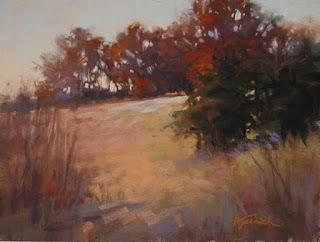 |
| November Reds, pastel, 9x12 |
For my demo of "November Reds" I began setting up those hard and soft edges right from the start in the underpainting, shown below...
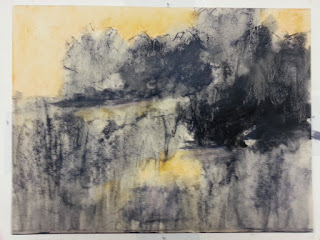 |
| Underpainting for November Reds |
Thursday, October 25, 2012
Study, study, study!
In all of my pastel classes this week we focused on doing small, timed studies. I find this to be a great exercise to not only prepare for a larger painting, but also to simply increase your painting skills (and painting speed) by getting more painting mileage behind you. Some other benefits to doing quick, small studies:
- You're more inclined to try different, riskier approaches since you know you won't have very much time invested in each little piece...you'll quickly see what works and what doesn't.
- You're less inclined to fuss over each area of the painting since it's not meant to be a finished piece.
- You'll think more in terms of the "big picture" rather than minor details, which helps you to narrow in on what you want to say with the painting.
In my Thursday class, we focused on composition and painted three versions of the same landscape using different formats for each (square, vertical and horizontal), spending no more than about 20 - 30 minutes on each. Below are my demos of each...
In my Monday class earlier in the week we focused more on timed exercises to help everyone get more in the habit of blocking in larger shapes and quickly getting the entire surface covered, rather than getting caught up in unnecessary details. Students had 30 minutes to work on each of three separate paintings. Below are the two demos I did for that class:
The paintings at the top of this post are done on Sennelier LaCarte paper and the ones just above are on gatorboard prepared with pumice gel (toned first with a warm neutral color).
As I observed the progression of the three paintings each student did in each class, most every student made substantial improvements from the first one to the third one!
- You're more inclined to try different, riskier approaches since you know you won't have very much time invested in each little piece...you'll quickly see what works and what doesn't.
- You're less inclined to fuss over each area of the painting since it's not meant to be a finished piece.
- You'll think more in terms of the "big picture" rather than minor details, which helps you to narrow in on what you want to say with the painting.
In my Thursday class, we focused on composition and painted three versions of the same landscape using different formats for each (square, vertical and horizontal), spending no more than about 20 - 30 minutes on each. Below are my demos of each...
 |
| The Long and Winding Road I, 6x6 |
 |
| The Long and Winding Road II, 8x6 |
 |
| The Long and Winding Road III, 6x8 |
In my Monday class earlier in the week we focused more on timed exercises to help everyone get more in the habit of blocking in larger shapes and quickly getting the entire surface covered, rather than getting caught up in unnecessary details. Students had 30 minutes to work on each of three separate paintings. Below are the two demos I did for that class:
 |
| Does This Go Anywhere?, 10x8 |
 |
| Uphill, 10x8 |
As I observed the progression of the three paintings each student did in each class, most every student made substantial improvements from the first one to the third one!
Tuesday, October 16, 2012
Starting with a Plan
 |
| Evening Shade, pastel, 8x8 |
I always encourage my students to do preliminary thumbnails in order to plan two key aspects of their painting: composition and value. Here's a very brief explanation of how I do this:
1) Composition: Consider the balance of large and small shapes, the placement of your focal point (often using the "rule of thirds"), and avoid placing a key element in the center of the painting (horizontally or vertically). Of course many of these "rules" can be knowingly broken, but that's another blog post for another day.
2) Values: Try to simplify the composition down to 4 or 5 value groups. If done carefully in your planning stages, this makes the beginning of the painting faster, easier, and much less intimidating.
 |
| My thumbnail composition/value sketch. |
 |
| Black and white reference photo. |
Monday, October 8, 2012
Colorful Underpaintings in my Monday Class
 |
| November Marsh, pastel, 9x12 |
 |
| Underpainting for November Marsh |
November Marsh is my demo from this morning's class.
Monday, October 1, 2012
Underpainting in my Monday class.
 |
| Been Down This Road Before, pastel, 9x12 |
I used a mostly monochromatic underpainting to set the value structure, using a dark blue Nupastel to block in most of it and a very dark reddish-purple soft pastel to intensify only the darkest areas. Straying a bit from the monochromatic structure, I also added just a touch of a yellow-orange with a Nupastel to the lightest areas (the sky and road). Even for my monochromatic starts, lately I've been including a warm color to underlay my light areas when the ultimate color used in that area will be on the cool side...I find that this keeps the color from have a whitish, chalky look.
Sorry I don't have photos of the initial block in on this one.
Thursday, September 27, 2012
Immersed in Water, Part 2
 |
| Late Afternoon Reflections, pastel, 12x9 |
 |
| reference photo |
I went back and forth with how detailed to make the water ripples, as well as how hard and soft to make the edges. My distant trees seemed to be working with fairly soft edges, so I decided to keep the edges in the water mostly soft, except for a few areas that needed emphasis.
Regarding color (also part of my issue last week), I had to search for a way to handle the warm, peach highlights in the dark reflections in the water. I finally decided to interpret those warm highlights as more of a soft-edge glow rather than with linear strokes. This helped to give that upper right section of the painting an overall glow with it being placed near the warm, sunlit areas of the land and tree mass.
Still not being completely satisfied with this "problem painting," I thought the composition could be better...sooooooo...
 |
| Late Afternoon Reflections, pastel, 8x8 |
Monday, September 24, 2012
The Tree Portrait
 |
| Tree Study, 8x8, pastel |
We also discussed creating the overall shape of the tree, creating pleasing abstract shapes, rather than creating an exact copy of the shape as shown in the reference photo.
Thursday, September 20, 2012
Immersed in Water
 |
| Dancing on Water, pastel, 9x12 |
 |
| reference photo |
Dancing on Water is my demo from my Thursday class.
Monday, September 17, 2012
Minimal Stroke Exercise - Sept. 2012
 |
| Across the Lake, pastel, 7x5 |
To see an earlier post of a previous minimal stroke exercise for more details on how I go about this in my classes, click here: http://barbarajaenicke.blogspot.com/2012/01/creating-pastel-painting-with-minimal.html
Thursday, September 13, 2012
Making Photoshop do the squinting for you, Part 2
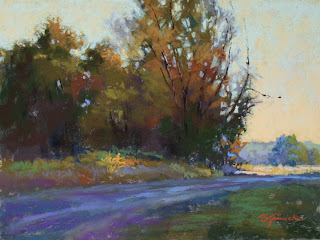 |
| The Light Beyond, pastel, 9x12 |
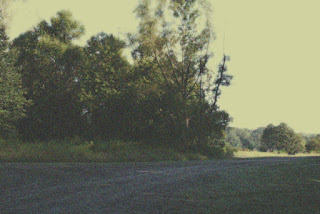 |
| blurred reference photo |
 |
| original photo |
Sorry, no step-by-step photos on this one, but my post from last week's class with the boats (link above) features demo photos.
Monday, September 10, 2012
First Day of the Fall Session at Spruill
 |
| "Sun and Shade" pastel, 9x12 |
So I try as much as possible to use the same supplies that they'll probably use on their first day. My "day 1" exercise: working from a black & white photo. This helps diminish the frustration of trying to match exact colors in a reference photo, and focus on seeing the color pastel sticks in terms of values.
 |
| reference photo |
*I should add that I do encourage my new students to gradually try the better pastels and surfaces, since for some artists, the better quality materials can make all the difference with whether they like the medium or not.
Thursday, September 6, 2012
Making Photoshop do the squinting for you.
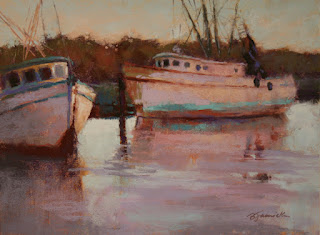 |
| Retired, pastel, 9 x 12 |
So I thought I'd try a little trick in Photoshop to create as close as possible how I'd see a photo if I was squinting at it. Now I'm no expert in Photoshop, but I played around with all the tools I could find that blur a photo and reduce details.
 |
| My blurred photo. |
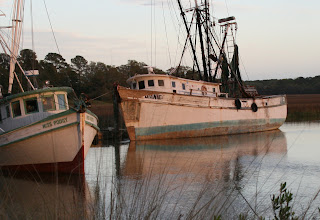 |
| My original photo. |
Below are a few shots from my demo that I did in my Thursday class this week. I started with some warm hues using Nupastels, and then used an alcohol wash (I use a stiff bristle brush for this). It's on Uart 400 grit mounted to acid free foam board.
Subscribe to:
Posts (Atom)



